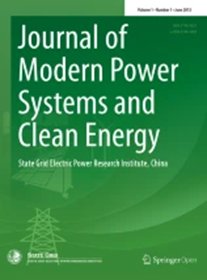Grid-Forming Control Based on Adaptive Reactive Power Allocation for Offshore Wind Farms Connected to Diode-rectifier-based HVDC System
IF 6.1
1区 工程技术
Q1 ENGINEERING, ELECTRICAL & ELECTRONIC
引用次数: 0
Abstract
Diode-rectifier-based high-voltage direct current (DR-HVDC) systems are considered an attractive solution for integrating offshore wind farms (OWFs). Grid-forming (GFM) control with a rational reactive power allocation capability is crucial for the safe operation of numerous wind turbines (WTs). Most typical GFM controls aim to share surplus reactive power of the system equally among WTs, easily rendering capacity overloads for WTs that are outputting high levels of active power. In this paper, a novel GFM control for OWFs is proposed, allowing for adaptively allocating the reactive power according to the actual active power output of WTs. Firstly, the reactive power characteristics of the AC collection networks and WTs are analyzed across a wide wind power range. Then, combining the positive correlation of WT active power with the output AC voltage, a Q-θ type GFM control for WTs is presented. The adaptive reactive power allocation mechanism and the parameter design of the Q-θ based reactive power controller are elucidated, ensuring that WTs with lower active power output contribute more reactive power to the system than WTs with higher active power output. The AC impedance models of WTs under various GFM controls are established to evaluate the impact of different reactive power controllers. Finally, the feasibility of the proposed control is validated in PSCAD/EMT-DC, accompanied by stability analysis.基于自适应无功功率分配的成网控制,适用于与基于二极管整流器的高压直流系统相连的海上风电场
基于二极管整流器的高压直流(DR-HVDC)系统被认为是集成海上风电场(owf)的一个有吸引力的解决方案。并网控制与合理的无功功率分配能力是众多风力发电机组安全运行的关键。大多数典型的GFM控制的目标是在wt之间平均共享系统的剩余无功功率,这很容易使输出高水平有功功率的wt产生容量过载。本文提出了一种新的无功调频控制方法,可以根据实际输出的有功功率自适应分配无功功率。首先,在较宽的风电功率范围内,分析了交流集网和wt的无功特性。然后,结合小波有功功率与输出交流电压的正相关关系,提出了小波有功功率的Q-θ型梯度调频控制。阐述了基于Q-θ的无功功率控制器的自适应无功功率分配机制和参数设计,保证了低有功输出wt比高有功输出wt对系统的无功功率贡献更大。建立了各种GFM控制下WTs的交流阻抗模型,以评估不同无功功率控制器对WTs的影响。最后,在PSCAD/EMT-DC中验证了所提控制的可行性,并进行了稳定性分析。
本文章由计算机程序翻译,如有差异,请以英文原文为准。
求助全文
约1分钟内获得全文
求助全文
来源期刊

Journal of Modern Power Systems and Clean Energy
ENGINEERING, ELECTRICAL & ELECTRONIC-
CiteScore
12.30
自引率
14.30%
发文量
97
审稿时长
13 weeks
期刊介绍:
Journal of Modern Power Systems and Clean Energy (MPCE), commencing from June, 2013, is a newly established, peer-reviewed and quarterly published journal in English. It is the first international power engineering journal originated in mainland China. MPCE publishes original papers, short letters and review articles in the field of modern power systems with focus on smart grid technology and renewable energy integration, etc.
 求助内容:
求助内容: 应助结果提醒方式:
应助结果提醒方式:


